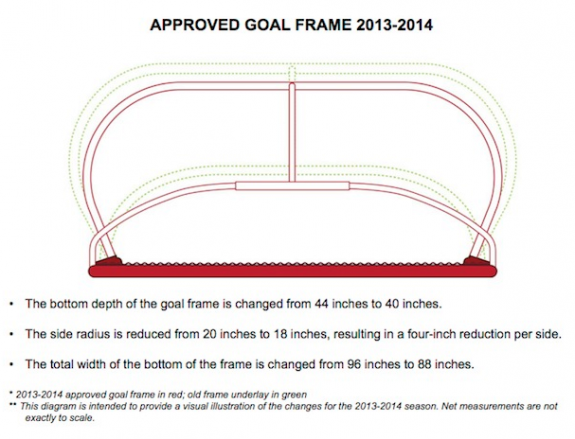Gretzky’s office has been expanded.
The NHL has switched to shallower nets for the 2013-14 season. The new nets are shallower, dropping four inches in depth, and not quite as wide, losing approximately four inches from each side below the goal line. It may not sound like much, but a little more space around back and on the sides can make a big difference.

A minor change was also made to the radius of the corner where the posts meet the crossbar. What was a gentler, rounded curve is now closer to a 90-degree angle. It’s not a drastic change, but it does slightly increase the space that a puck could go in. Watch those top corner shots; some that would have rung off the crossbar may now go off the post and in.
The overhead crossbar was also changed to make it less likely to obscure overhead replays.
Net Impact
Wraparound Goals
The additional real estate will give the offense more room to move the puck and make a play. Unlike the goal line move of 1998 – when the league moved the nets an additional two feet from the end boards – this change won’t open it up wide enough for defensemen to blaze through and clear out players behind the net. That move created 9’4″ of space back there. It also ended during the lockout, when the goal lines reverted to their original distance of 11 feet out. The new, svelte nets increase the space behind the goal from 7′ 4″ to 7′ 8″. With more space to move and a narrower net, expect more wraparound attempts. The puck has a much shorter distance to travel to make it from behind the net to around the post and in.
Here’s the Islanders’ Riley Wetmore using that extra space to net a wraparound goal in the Isles final preseason game.
“Obviously [wraparounds will be] an easier thing to do,” Maple Leafs coach Randy Carlyle told the Toronto Star. “The bigger men playing the game can take advantage of it. It’s something the goalies are going to have to work on. It’s a shorter distance around the net for the player to stuff [the puck] and do a wraparound.”
Adjusting to Angles
In addition to the threat of faster wraparounds, goaltenders will also have to adjust to the changing angles of pucks coming from behind the net. The narrower frame and tighter curves increase the room below the goal line where passes can find their way into the slot. Great passers will quickly learn how to take advantage.
Kings goaltender Ben Scrivens spoke about the possible changes in gameplay:
“You can be on the far side and do a behind-the-back reverse pass out to the short side. If the guy is coming from the corner, going behind the net and he’ll be able to put it back to where he just came. With the shallower net, he can almost get farther to one side of the net before the point of no return.”
“My guess would be it would add more playmaking ability to the skill players behind the net, but conversely it gives the defencemen more time behind the net, more room to make plays. It might help them to break the puck out even easier, which is less conducive to offence.”
Expect an increase in low-to-high plays, with more puck movement from below the goal line to players in the slot. The changes might make for some unfamiliar angles that catch goaltenders off guard, and the additional space will certain lead to more bang-bang passing plays.
Really like the extra bit of space behind the goalie thanks to shallower nets. More room for random havoc. The NHL could use that. #THNLive
— The Hockey News (@TheHockeyNews) October 1, 2013
Goaltenders will also be more vulnerable to bank plays, as the new net footprint provides less protection for goaltenders from behind the post. The wide ‘belly’ of the net shielded goaltenders from plays behind the net. With a slimmer, trimmer goal, goaltenders not positioned perfectly against the post are more likely to have pucks bounce off their backs and in. Just something to watch for, especially for netminders that tend to play far out from the goal line.
Smaller Net, Bigger Trapezoid
Smaller nets will open up more space for offense, but they also allow some of the more active goaltenders a bit more space to play the puck within the trapezoid. Of course, there’s always the chance they wander too far and get caught back there, like Ray Emery did below.
Defensive Help
Don’t think the benefits are solely for the attacking team. Defenders will have a bigger passing lane to play the puck behind the net, which should help sped up breakouts.
“I really believe the defensemen [will have an advantage] because I think you can make a direct pass now without bouncing it off the boards whereas before it was pretty hard,” said Blues coach Ken Hitchcock. “Everybody’s talking about wraparounds and all that stuff, but it’s not that many inches. You’re going to be able to make lateral passes there, but I think it’s more for the passing than it is for the wraparounds.”
The History of Gretzky’s Office
This isn’t the first time the league has changed things around behind the net in an attempt to generate offense.
- Pre-1990 – Goal line is approximately 10′ from end boards, though somewhat inconsistent at each arena.
- 1990-91 – Goal line moved out one foot from end boards, creating 11’ of room behind the nets. Nets officially standardized at 44” deep and 96” wide
- 1998-99 – Goal line moved out two feet from end boards, to 13’. Despite the offensive intentions behind the change, goal scoring actually dropped. From 1998-2004, the NHL had its lowest average goals per game in 40 years.
- 2005-06 – Goal line moved back to 11’ from end boards. While the return of the goal lines to their original location may have helped, the post-lockout change in officiating philsophy is what pushed goals-per-game over 3.0 for the first time since 1995-96.
- 2013-14 – Shallower net, reduced from 44″ to 40″ deep. Width of net reduced from 96″ to 88″ at its widest point. Coming off four years of steadily decreasing goals-per-game, it’s yet to be seen if this will move the needle in the other direction.
Player Thoughts
“It creates a little more room behind the net and even around the net feels like a little more room, so it should make a bit of difference. The more room you have behind, the more opportunity it gives you to make plays.” – Mikko Koivu, Minnesota Wild (via Star Tribune)

“It’s going to be that split second quicker. You’re going to have to be on your toes there. The nets didn’t change width-wise or height-wise. It’s just depth-wise behind the net. It’s definitely going to have its advantages for forwards, but also for your own team as well.” – Blues goaltender Jake Allen (via STL Today)
Jimmy Howard, goaltender with the Wings, downplayed the change to the Detroit Free Press, saying, “I really don’t think there’s going to be much of a difference.”
The NHL sure hopes you’re wrong, Jimmy.
Follow Josh on Twitter – @joshsmith29